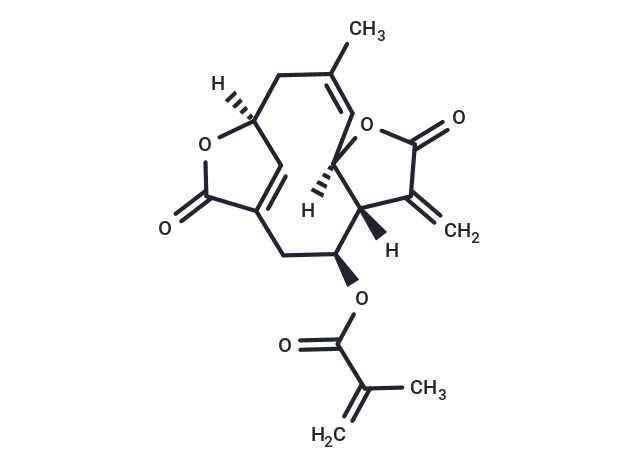Shopping Cart
- Remove All
 Your shopping cart is currently empty
Your shopping cart is currently empty

Isodeoxyelephantopin can inhibit the growth of various tumor cells.

| Pack Size | Price | Availability | Quantity |
|---|---|---|---|
| 1 mg | $228 | In Stock | |
| 5 mg | $579 | In Stock | |
| 10 mg | $826 | In Stock | |
| 25 mg | $1,220 | In Stock | |
| 50 mg | $1,650 | In Stock | |
| 1 mL x 10 mM (in DMSO) | $587 | In Stock |
| Description | Isodeoxyelephantopin exerts antitumor effects on several cancer cells by inducing apoptosis , cell cycle arrest , and inhibiting proliferation. It enhances apoptosis and inhibit invasion and osteoclastogenesis by inhibiting NF-kappaB activation and NF-kap |
| In vitro | Isodeoxyelephantopin inhibits the growth of A549 and T47D cells in a dose-dependent and time-dependent manner with IC50 values of 10.46 and 1.3 μg/mL, respectively. Heterodeoxyelephantin showed no significant toxicity to normal lymphocytes. Heterodeoxyelephinin-induced cell death is associated with activated caspase-3 expression, followed by cell cycle stagnation in G2/M phase [1] |
| Molecular Weight | 344.36 |
| Formula | C19H20O6 |
| Cas No. | 38927-54-7 |
| Smiles | [H][C@]12C\C(C)=C/[C@@]3([H])OC(=O)C(=C)[C@]3([H])[C@H](CC(=C1)C(=O)O2)OC(=O)C(C)=C |
| Relative Density. | 1.26 g/cm3 (Predicted) |
| Storage | Powder: -20°C for 3 years | In solvent: -80°C for 1 year | Shipping with blue ice. | |||||||||||||||||||||||||||||||||||
| Solubility Information | DMSO: 55 mg/mL (159.72 mM), Sonication is recommended. | |||||||||||||||||||||||||||||||||||
Solution Preparation Table | ||||||||||||||||||||||||||||||||||||
DMSO
| ||||||||||||||||||||||||||||||||||||

Copyright © 2015-2025 TargetMol Chemicals Inc. All Rights Reserved.